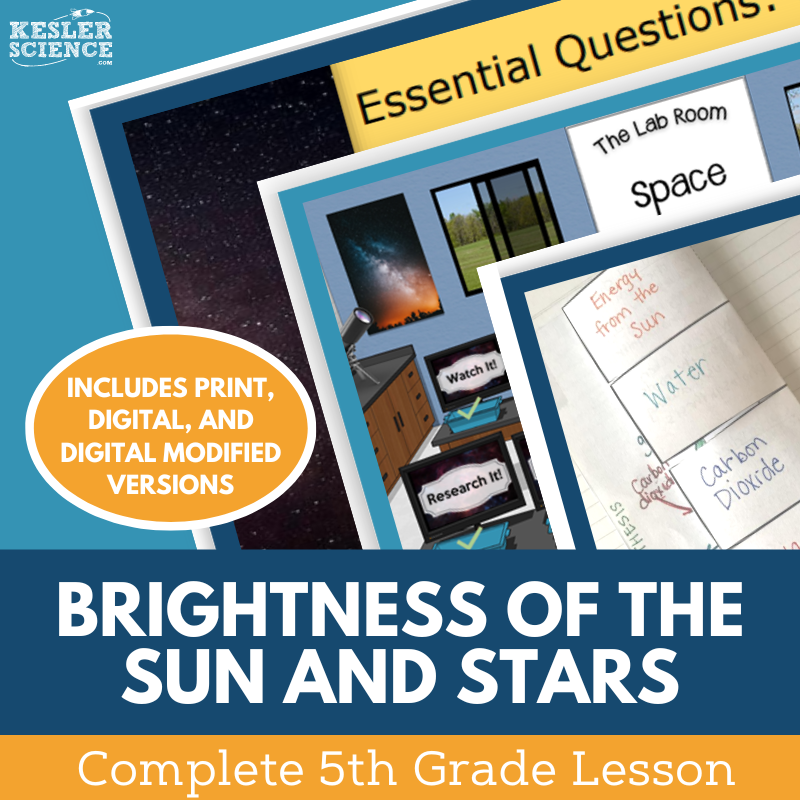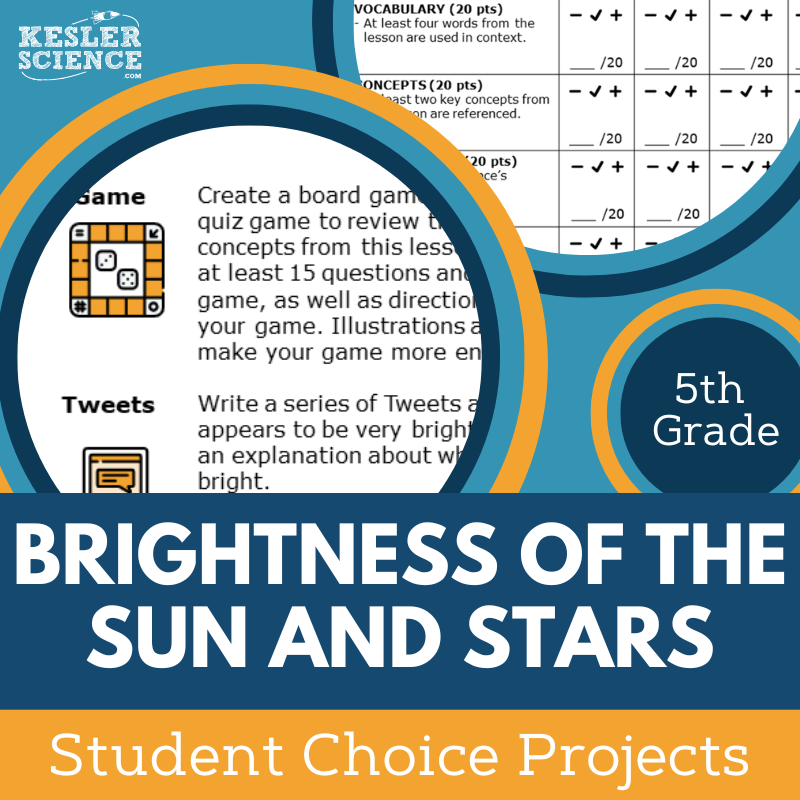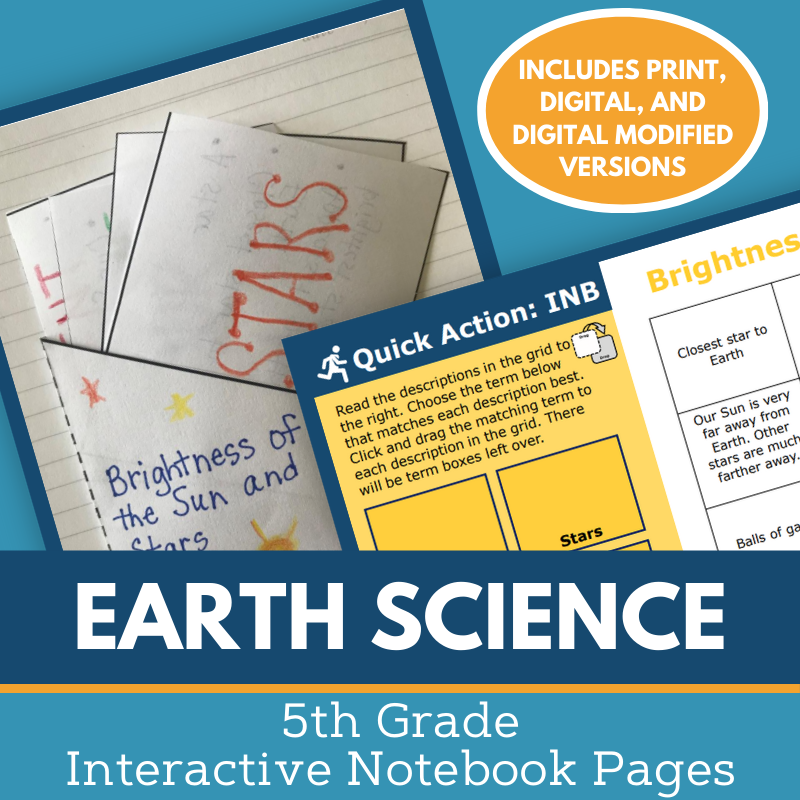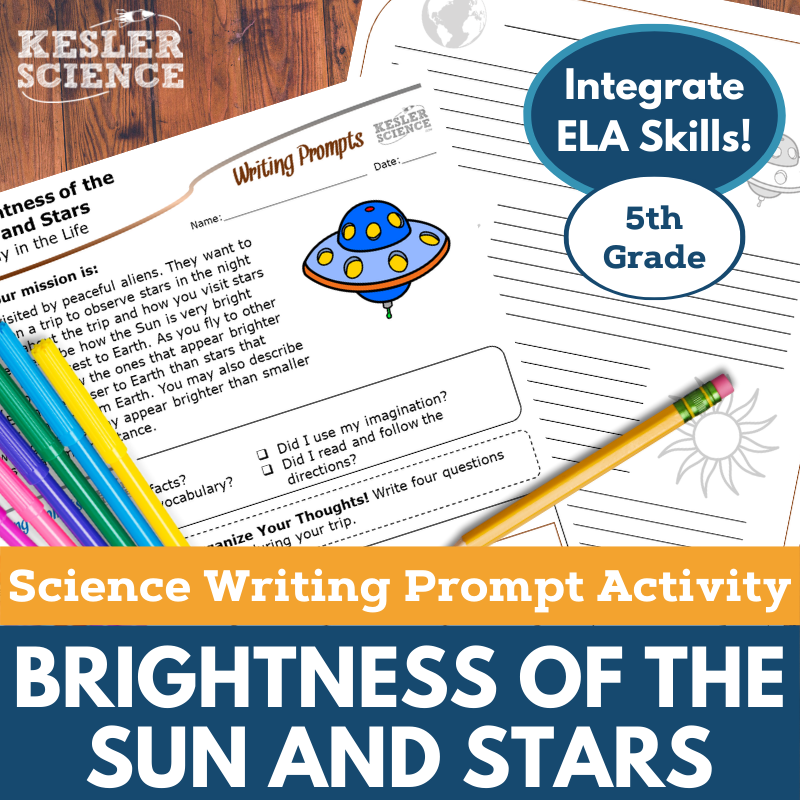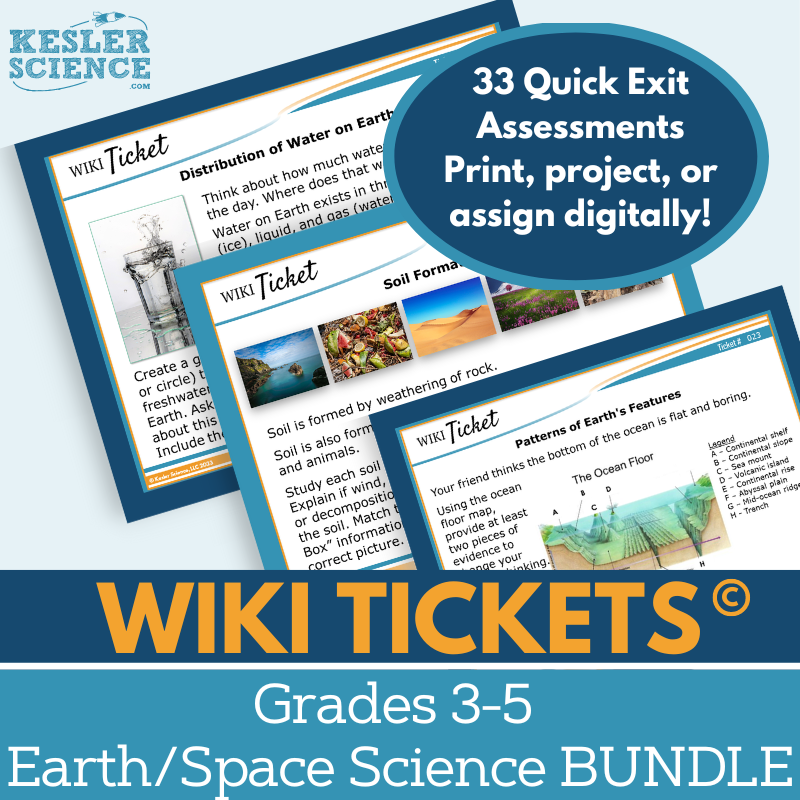Brightness of the Sun and Stars Activities for 5th Grade Science
Understanding why the Sun appears the brightest in our sky is made simple with this engaging Earth science lesson. The resources below will give students a comprehensive understanding of the brightness and relative distances of the Sun and other stars. All of the following materials are also included in the Kesler Science Membership.
The Kesler Science Brightness of the Sun and Stars 5E Lesson is a comprehensive Earth science unit designed for elementary students. It includes editable presentations, worksheets, choice projects, and assessments, requiring little to no prep. The lesson supports differentiated, student-led learning and is available in both print and digital formats.
Students explore how a star’s relative distance affects its brightness in Earth’s sky and why the Sun appears the brightest. The unit follows the 5E Model, featuring engaging discussion prompts and activities. A hands-on, student-led station lab offers nine multimodal stations, including hands-on experiments, reading passages in English and Spanish, video discussions, and interactive categorization tasks.
The explanation phase includes editable PowerPoints, interactive notebook templates, and note-taking guides. Students extend their learning through choice projects, and evaluation consists of STAAR 2.0-aligned assessments, review questions, and worksheets. Spanish translations are provided for vocabulary, reading passages, and notebook pages.
This resource is fully adaptable for both classroom and virtual learning, with digital components ensuring flexibility in any setting.
The Kesler Science Brightness of the Sun and Stars 5E Lesson is a comprehensive Earth science unit designed for elementary students. It includes editable presentations, worksheets, choice projects, and assessments, requiring little to no prep. The lesson supports differentiated, student-led learning and is available in both print and digital formats.
Students explore how a star’s relative distance affects its brightness in Earth’s sky and why the Sun appears the brightest. The unit follows the 5E Model, featuring engaging discussion prompts and activities. A hands-on, student-led station lab offers nine multimodal stations, including hands-on experiments, reading passages in English and Spanish, video discussions, and interactive categorization tasks.
The explanation phase includes editable PowerPoints, interactive notebook templates, and note-taking guides. Students extend their learning through choice projects, and evaluation consists of STAAR 2.0-aligned assessments, review questions, and worksheets. Spanish translations are provided for vocabulary, reading passages, and notebook pages.
This resource is fully adaptable for both classroom and virtual learning, with digital components ensuring flexibility in any setting.
Engage your 5th-grade students in a student-led exploration of the brightness of the Sun and stars with this interactive station lab. Designed to promote independent learning, this lesson provides students with engaging, multimodal activities while minimizing teacher prep time.
Students will investigate and compare star brightness through nine interactive stations, including hands-on experiments, research, reading, and video-based learning. They demonstrate understanding by organizing information, illustrating models, writing responses, and completing assessments. A challenge station offers extension activities for early finishers, and differentiated reading passages in English and Spanish support diverse learners.
This flexible, high-engagement resource is designed for both in-class and virtual learning, ensuring accessibility in any setting.
Engage your 5th-grade students in a student-led exploration of the brightness of the Sun and stars with this interactive station lab. Designed to promote independent learning, this lesson provides students with engaging, multimodal activities while minimizing teacher prep time.
Students will investigate and compare star brightness through nine interactive stations, including hands-on experiments, research, reading, and video-based learning. They demonstrate understanding by organizing information, illustrating models, writing responses, and completing assessments. A challenge station offers extension activities for early finishers, and differentiated reading passages in English and Spanish support diverse learners.
This flexible, high-engagement resource is designed for both in-class and virtual learning, ensuring accessibility in any setting.
The Brightness of the Sun and Stars Student Choice Projects lesson allows 5th-grade students to demonstrate their understanding through a project that matches their preferred output style. A project page outlines six student-led options plus a “design your own” project, with an editable rubric for teacher, peer, or self-assessment.
These flexible, multimodal projects provide creative ways for students to showcase their knowledge. Two versions of the project page support differentiation, offering modified options for students needing remediation and challenge opportunities for advanced learners. Teachers can adjust the rubric to fit their grading needs.
The projects use standard classroom supplies like paper, markers, and scissors, with many options available for digital completion.
The Brightness of the Sun and Stars Student Choice Projects lesson allows 5th-grade students to demonstrate their understanding through a project that matches their preferred output style. A project page outlines six student-led options plus a “design your own” project, with an editable rubric for teacher, peer, or self-assessment.
These flexible, multimodal projects provide creative ways for students to showcase their knowledge. Two versions of the project page support differentiation, offering modified options for students needing remediation and challenge opportunities for advanced learners. Teachers can adjust the rubric to fit their grading needs.
The projects use standard classroom supplies like paper, markers, and scissors, with many options available for digital completion.
This 5th Grade Earth Science Interactive Notebook is essential for teachers seeking to maximize student engagement when teaching elementary earth science concepts. It is versatile for traditional classrooms, 1:1 digital settings, or distance learning, providing both digital and paper versions. Digital resources feature interactive PowerPoint files compatible with Google Slides, MS Teams, Schoology, and Canvas, reflection pages, note-taking spaces, teacher answer keys, and modified versions for students needing accommodations. The paper resources include blank templates, pre-filled versions for absent or modified instruction students, and color photos demonstrating template usage.
Topics covered include the brightness of the Sun and stars, observable patterns of the sky, Earth's spheres, the distribution of water on Earth, protecting Earth's resources, sedimentary rock and fossil fuels, changes to Earth's surface, weather and climate, the water cycle, Earth’s rotation, and the Sun, the Moon, and Earth. These notebook templates also integrate seamlessly into Kesler Science 5E Lessons.
This 5th Grade Earth Science Interactive Notebook is essential for teachers seeking to maximize student engagement when teaching elementary earth science concepts. It is versatile for traditional classrooms, 1:1 digital settings, or distance learning, providing both digital and paper versions. Digital resources feature interactive PowerPoint files compatible with Google Slides, MS Teams, Schoology, and Canvas, reflection pages, note-taking spaces, teacher answer keys, and modified versions for students needing accommodations. The paper resources include blank templates, pre-filled versions for absent or modified instruction students, and color photos demonstrating template usage.
Topics covered include the brightness of the Sun and stars, observable patterns of the sky, Earth's spheres, the distribution of water on Earth, protecting Earth's resources, sedimentary rock and fossil fuels, changes to Earth's surface, weather and climate, the water cycle, Earth’s rotation, and the Sun, the Moon, and Earth. These notebook templates also integrate seamlessly into Kesler Science 5E Lessons.
The Brightness of the Sun and Stars Science Writing Activity engages 5th-grade students in an interactive "A Day in the Life" story model to explore Earth science concepts. This low-prep, student-centered activity reinforces science reasoning and writing skills in both print and digital formats, making it suitable for in-person or virtual learning.
Aligned with NGSS 5-ESS1-1, this resource includes teacher directions with answer guides, project ideas, and rubrics, along with projection and print-friendly handouts. Full-sized and half-sheet versions provide a structured writing prompt, student self-checks, and pre-writing strategies. A digital interactive version, available in PowerPoint and Google Slides, allows for seamless online use.
This writing prompt is ideal for cross-curricular activities, pre-test assessments, student choice projects, early finisher elaboration, extra credit, make-up work, and differentiation exercises. It also works well as a TELPAS sample or for display on bulletin boards or in student anthologies. Designed for review, this activity assumes prior knowledge of the topic or access to research materials.
The Brightness of the Sun and Stars Science Writing Activity engages 5th-grade students in an interactive "A Day in the Life" story model to explore Earth science concepts. This low-prep, student-centered activity reinforces science reasoning and writing skills in both print and digital formats, making it suitable for in-person or virtual learning.
Aligned with NGSS 5-ESS1-1, this resource includes teacher directions with answer guides, project ideas, and rubrics, along with projection and print-friendly handouts. Full-sized and half-sheet versions provide a structured writing prompt, student self-checks, and pre-writing strategies. A digital interactive version, available in PowerPoint and Google Slides, allows for seamless online use.
This writing prompt is ideal for cross-curricular activities, pre-test assessments, student choice projects, early finisher elaboration, extra credit, make-up work, and differentiation exercises. It also works well as a TELPAS sample or for display on bulletin boards or in student anthologies. Designed for review, this activity assumes prior knowledge of the topic or access to research materials.
The WIKI Tickets© Formative Assessments provide engaging, colorful ways to quickly gauge student understanding in 3rd–5th grade science. The Earth/Space Science Set includes 33 topics, each offering five flexible formats: a full-screen projection option, three printable handouts (full, split, and quarter-page sizes), and an interactive digital version compatible with PowerPoint and Google Slides.
Aligned with NGSS and TEKS standards, these assessments cover essential topics such as the brightness of the Sun and stars, patterns of change: seasons and shadows, the water cycle, and the Sun. They work effectively as exit tickets, bellringers, or quick checks, suitable for both in-person and virtual classrooms.
The WIKI Tickets© Formative Assessments provide engaging, colorful ways to quickly gauge student understanding in 3rd–5th grade science. The Earth/Space Science Set includes 33 topics, each offering five flexible formats: a full-screen projection option, three printable handouts (full, split, and quarter-page sizes), and an interactive digital version compatible with PowerPoint and Google Slides.
Aligned with NGSS and TEKS standards, these assessments cover essential topics such as the brightness of the Sun and stars, patterns of change: seasons and shadows, the water cycle, and the Sun. They work effectively as exit tickets, bellringers, or quick checks, suitable for both in-person and virtual classrooms.
Year-Round Resources
These year-round activities will increase your students' understanding of many middle school science topics. All of these activities are also included in the Kesler Science Membership.
Visual Data & Graphing
You're not alone if your students struggle with understanding graphs, charts, and tables. It's a skill that takes an enormous amount of practice. This resource will help students build a strong foundation in analyzing data and creating their own data visualizations.
Bell Ringers and Warm-Ups
These middle school science bell ringers are an excellent way to engage your students as soon as they walk into your classroom. This comprehensive FULL YEAR resource includes everything you need to start off each science class with an interesting warm-up activity.
Review Board Games
Each game board has been carefully designed to keep students engaged. There are 10 different action spaces on each board and dozens of question cards. All of the actions are related to science concepts and keep the students motivated throughout the game.
Each game is ready to play. Simply print out the board and the cards and let the students enjoy reviewing nine different units.
Essential Questions and Standards
Below are the essential questions and standards associated with the lessons and activities included in the brightness of the Sun and stars unit. This topic is only one of more than 100 middle school science topics included in the Kesler Science Membership.
-
How does the relative distance of a star affect how brightly it shines in Earth’s sky?
-
Why is the Sun the brightest star in Earth’s sky?
-
NGSS - 5-ESS1-1 Brightness of the Sun and Stars
Kesler Science Membership
Imagine never having to search for another middle school science lesson again. The membership gives you access to ALL of the Kesler Science products in one place (Yes, including everything above).
Say goodbye to long hours of lesson prep.

